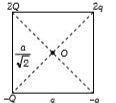Four point charges −Q,−q,2q and 2Q are placed, one at each corner of the square. The relation between Q and q for which the potential at the centre of the square is zero is
Q = q
Q=−1q
Q = q
Q=1q
The correct Answer is:A

V = 0
⇒K(−Q)a√2+K(−q)a/√2+K(2q)a/√2+K(2Q)a/√2=0
⇒−Q−q+2q+2Q=0⇒Q=−q
Similar Questions
Four point charges −Q,−q,2q and 2Q are placed, one at each corner of the square. The relation between Q and q for which the potential at the centre of the square is zero is
View SolutionFour point charges −Q,−q,2q and 2Q are placed, one at each corner of the square. The relation between Q and q for which the potential at the centre of the square is zero is
View SolutionFour point charges -Q, -q, 2q and 2Q are placed, one at each comer of the square. The relation between Q and q for which the potential at the centre of the square is zero is.
View SolutionFour point charges -Q, -q . 2q and 2Q are placed each corner of the square. The relation between Q and which the potential at the centre of the square is zero.
View Solutionकिसी वर्ग के चारों कोनो पर बिंदु आवेश −Q,q,2g तथा 2Q क्रमशः रखे गए हैं। Q तथा q के बीच क्या संबंध होना चाहिए जिससे वर्ग केंद्र पर विभव शून्य हो जाए
View Solutionकिसी वर्ग के चार कोनों पर बिन्दु आवेश -Q,-q, 2q तथा 2Q क्रमशः रखे गये हैं। ए तथा q के बीच क्या संबंध होना चाहिये, ताकि वर्ग के केन्द्र पर विभव शून्य हो जाए.
View SolutionFour point charges -Q,-q,2q and 2Q are placed , one at each corner of the square. The relation between Q and q for which the potential at the centre of the square is zero is :
View SolutionFour point charges −Q,−q,2q and 2Q are placed, one at each corner of the square. The relation between Q and q for which the potential at the centre of the square is zero is
View Solution